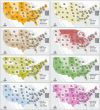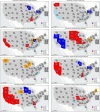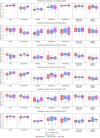How politics affect pandemic forecasting: spatio-temporal early warning capabilities of different geo-social media topics in the context of state-level political leaning
- PMID: 40666148
- PMCID: PMC12259613
- DOI: 10.3389/fpubh.2025.1618347
How politics affect pandemic forecasting: spatio-temporal early warning capabilities of different geo-social media topics in the context of state-level political leaning
Abstract
Objectives: Due to political polarization, adherence to public health measures varied across US states during the COVID-19 pandemic. Although social media posts have been shown effective in anticipating COVID-19 surges, the impact of political leaning on the effectiveness of different topics for early warning remains mostly unexplored. Our study examines the spatio-temporal early warning potential of different geo-social media topics across republican, democrat, and swing states.
Methods: Using keyword filtering, we identified eight COVID-19-related geo-social media topics. We then utilized Chatterjee's rank correlation to assess their early warning capability for COVID-19 cases 7 to 42 days in advance across six infection waves. A mixed-effect model was used to evaluate the impact of timeframe and political leaning on the early warning capabilities of these topics.
Results: Many topics exhibited significant spatial clustering over time, with quarantine and vaccination-related posts occurring in opposing spatial regimes in the second timeframe. We also found significant variation in the early warning capabilities of geo-social media topics over time and across political clusters. In detail, quarantine related geo-social media post were significantly less correlated to COVID-19 cases in republican states than in democrat states. Further, preventive measure and quarantine-related posts exhibited declining correlations to COVID-19 cases over time, while the correlations of vaccine and virus-related posts with COVID-19 infections.
Conclusion: Our results highlight the need for a dynamic spatially targeted approach that accounts for both how regional geosocial media topics of interest change over time and the impact of local political ideology on their epidemiological early warning capabilities.
Keywords: epidemiological early warning; geo-social media; political polarization; spatio-temporal epidemiology; spatio-temporal semantic analysis.
Copyright © 2025 Arifi, Resch, Santillana, Knoblauch, Lautenbach, Jaenisch and Morales.
Conflict of interest statement
The authors declare that the research was conducted in the absence of any commercial or financial relationships that could be construed as a potential conflict of interest.
Figures





Similar articles
-
Geosocial Media's Early Warning Capabilities Across US County-Level Political Clusters: Observational Study.JMIR Infodemiology. 2025 Jan 30;5:e58539. doi: 10.2196/58539. JMIR Infodemiology. 2025. PMID: 39883923 Free PMC article.
-
Measures implemented in the school setting to contain the COVID-19 pandemic.Cochrane Database Syst Rev. 2022 Jan 17;1(1):CD015029. doi: 10.1002/14651858.CD015029. Cochrane Database Syst Rev. 2022. Update in: Cochrane Database Syst Rev. 2024 May 2;5:CD015029. doi: 10.1002/14651858.CD015029.pub2. PMID: 35037252 Free PMC article. Updated.
-
Public Health Messaging on Twitter During the COVID-19 Pandemic: Observational Study.J Med Internet Res. 2025 Feb 5;27:e63910. doi: 10.2196/63910. J Med Internet Res. 2025. PMID: 39908546 Free PMC article.
-
A Pilot Study of Political Experiences and Barriers to Voting Among Autistic Adults Participating in Online Survey Research in the United States.Autism Adulthood. 2025 May 28;7(3):261-272. doi: 10.1089/aut.2023.0119. eCollection 2025 Jun. Autism Adulthood. 2025. PMID: 40539217
-
Physical interventions to interrupt or reduce the spread of respiratory viruses.Cochrane Database Syst Rev. 2023 Jan 30;1(1):CD006207. doi: 10.1002/14651858.CD006207.pub6. Cochrane Database Syst Rev. 2023. PMID: 36715243 Free PMC article.
References
-
- Cowan SK, Mark N, Reich JA. COVID-19 vaccine hesitancy is the new terrain for political division among Americans. Socius. (2021) 7:23780231211023657. 10.1177/23780231211023657 - DOI
MeSH terms
LinkOut - more resources
Full Text Sources
Medical

